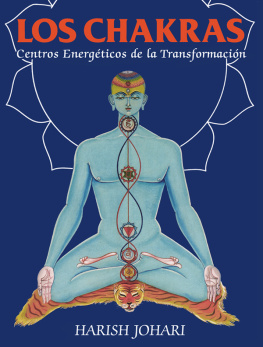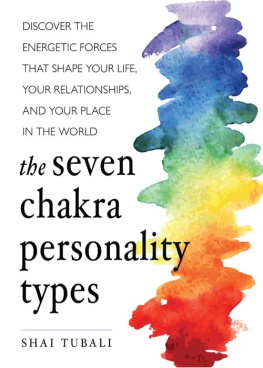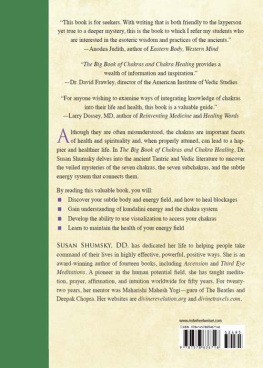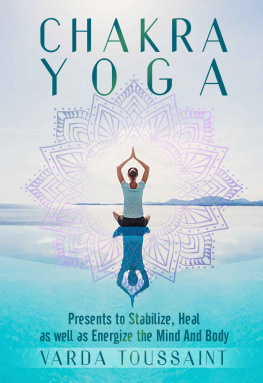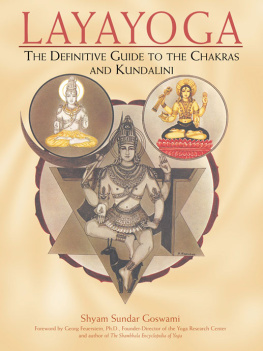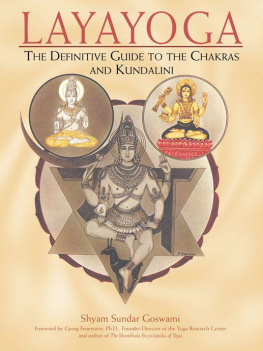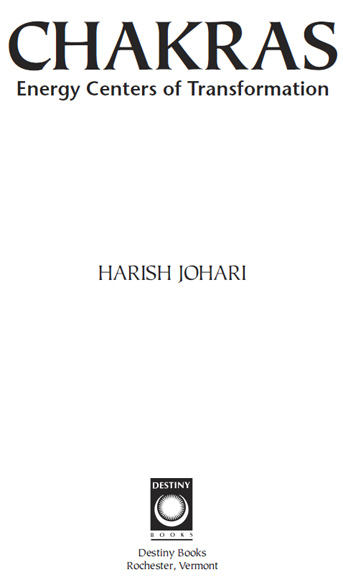

Acknowledgments
I would like to thank Pieter Weltevrede for preparing the line drawings and paintings for the first through sixth chakras for this revised edition, which were based on classical drawings and paintings of the chakras rendered by Sandeep Johari that appeared in the first edition of Chakras. I am very grateful to my teacher Shri C. Bal, who guided both Sandeep and Pieter in preparing these colored illustrations, and to Heidi Rauhut for preparing the first copy of the revised text of this new edition.
I am very thankful to H. H. Shripadji, Ganesh Baba, and Acharya Chandrashakhar Shastri for their clarification and guidance on various issues, and for enriching my knowledge by their teachings, blessings, and presence, which inspired me to under take the job.
Finally, I thank all of my friends and students whose valuable suggestions have helped me prepare this book, and I hope that it in turn will be helpful as a guidebook to the chakras.

Harish Johari left his body on August 20, 1999, at his home in the holy town of Haridwar. Pratibha Johari, family members, and Harishs students would like to thank the publisher, Ehud C. Sperling, for making it possible to continue Harishs work. Many thanks also to the editors, Jeanie Levitan and Nancy Yeilding, for their intensive collaboration on this edition.
Contents
Introduction
This book is an introduction to the classical understanding of chakras, which are most simply defined as psychic centers of transformation that enable one to move toward an enlightened state of being. Although the roots of the knowledge about chakras are of ancient origin, this knowledge is still functionally practical today. Chakra is a Sanskrit word that means a wheel, a disc, or any arrangement in circular form or organization. The ancient sources depict each of the seven major chakras as a lotus blossom, a circular form surrounded by petals, as we shall see illustrated in chapter 3, The Essentials of the Chakras. The word chakra also indicates movement. Chakras introduce movement because they transform psychophysical energy into spiritual energy.
Psychophysical energy is electrochemical in nature and it works with the help of prana. Prana is the energy that creates life, matter, and mind. The word prana means vital life force. Although our organism draws prana in through our nostrils as we breathe, dynamic prana energy is not based on the physiochemical system of the body; it operates super-physically through a wireless system rather than through the nervous system.
Our body exists at two levels. The gross material level is composed of the seven dhatusflesh, bone, clay, blood, fat, marrow, fluidsand the five elementsearth, water, fire, air, and akasha (the void or space). The subtle level is composed of the vital life force (prana), mind (manas), intellect (buddhi), ego (ahamkara), and the feeling self (chitta). Prana is the means by which the subtle and the gross in the human organism are connected. It activates all of the systems in the body, including the nervous system, and helps them work together as they should.
Prana is distributed throughout the body by Nadis, channels of energy. The Nadi transport system belongs to the subtle body and the chakras are connected to the main Nadi of this system, the Sushumna, which operates within the vertebral (spinal) column. Chakras thus do not belong to the material body and cannot be described fully from a materialistic standpoint. Just as a painting cannot be described merely from the standpoint of its lines, curves, or varying shades of color, even though these can be said to form its basic structure, chakras cannot be defined physiologically, or through any physical science such as neurochemistry. However, chakras are not imaginary centers; they are subtle centers that can be activated by the techniques described in this book.
Chakras are active at all times, whether we are conscious of them or not. Energy influenced by the elementsearth, water, fire, air, and akashamoves through the chakras, producing different psychic states. These elements (tattvas) are constantly moving with the breath inside the body and influencing ones temperament. (These changes are understood by neurobiologists as chemical changes produced by the endocrine glands, ductless glands whose secretions mix into the bodys blood stream directly and instantaneously.) With training, it is possible to observe oneself and see energy moving through these various psychic centers. In chapter 3, The Essentials of the Chakras, we will explain in detail the attributes and effects of the chakras. We also will explore the behavioral characteristics related to the chakras, which are not typically found in books on the subject.
There are seven major chakras, associated with the areas of the body and the elements as shown:
- Muladhara Chakra: the base of the spine and the element earth
- Svadhishthana Chakra: the genitals and the element water
- Manipura Chakra: the navel and the element fire
- Anahata Chakra: the heart and the element air
- Vishuddha Chakra: the throat and the element akasha (void or space)
- Ajna Chakra: the point between the eyebrows and mahatattva, the combination of the essence of all the elements in their purest form
- Sahasrara Chakra: the crown of the head, transcending all elemental influence; includes the Soma Chakra, associated with the area above the third eye or point between the eyebrows
Knowledge about the chakras as psychic centers can be a valuable key to introspection. One can see oneself going through mental fluctuations that arise from a constant interaction between the mind, intellect, ego, and the world outside. In the very beginning of his Yoga Sutra, Patanjali states: To control these mental fluctuations is Yoga. Control of these mental modifications is only possible by controlling prana. Therefore, the control of prana, called pranayama, is the primary step in the spiritual path of Yoga. Yoga offers instruction in spiritual practices (sadhana) which make an aspirant the best friend of his or her own body.
This book is about the practices of Tantra Yoga, also called Maha Yoga, the primary origin of the system of working with chakras and the dormant Kundalini energy. Through yogic practice, one gains the ability to expend the least possible physiochemical energy for mentation and to maintain the bodys vitality. That enables one to divert pranic (of prana) energy to activate ones dormant spiritual energy, called Kundalini. This energy in its dormant state is visualized as a snake coiled up in the first chakra at the base of the spine, the Muladhara Chakra.
When an aspirant (sadhaka) of Yoga starts activating the Kundalini energy through various kinds of pranayamas, the Nadi system is vitalized. The roused energy moves upward in the central Nadi, the Sushumna, passing through each of the six lower chakras to reach the seventh, the Sahasrara Chakra. This progress is known as kshata chakra bhedana (piercing of the six chakras). The release and ascent of the dormant spiritual energy enables the aspirant to transcend the effects of the elements and achieve the nondual consciousness that brings liberation from the ever-changing world of illusion
Next page

